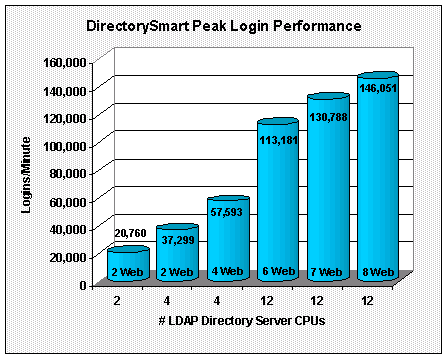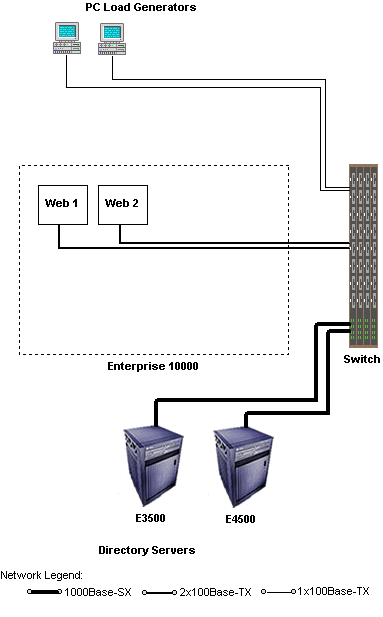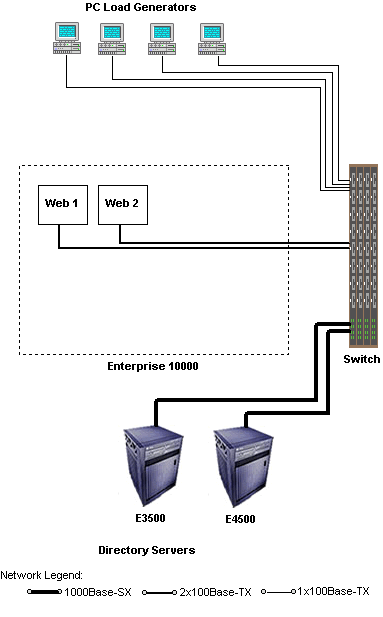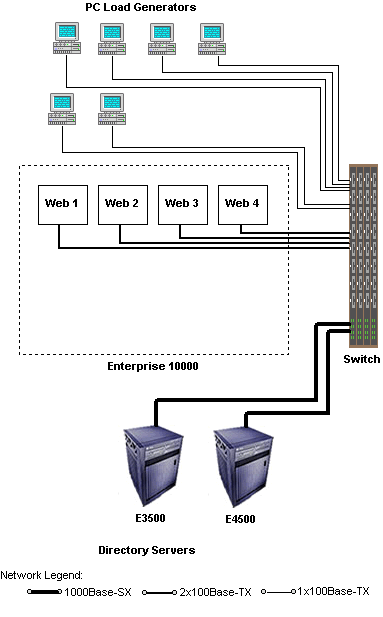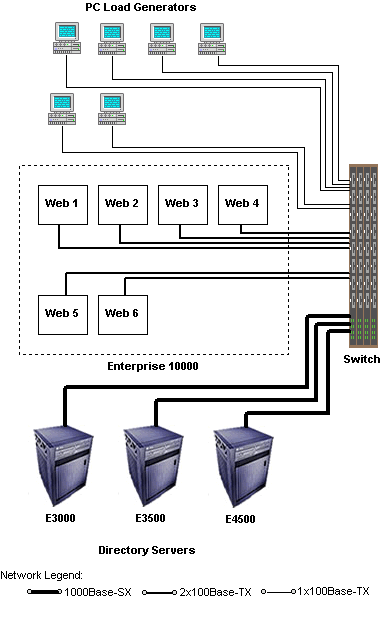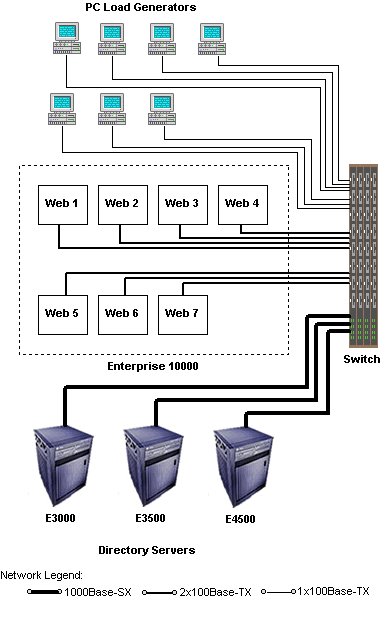 |
OpenNetwork Technologies DirectorySmart 4.6
|
|||||||||||||||||||||||||||||||||||||||||||||||||||||||||||||||||||||||||||||||||||||||||||||||||||||||||||||||||||||||||||||||||||||||||||||||||||||||||||||||||||||
Contents
AcknowledgmentWe thank Stefan Hinker, Benchmark Engineer at Sun's Benchmark Center in Langen, Germany, which is part of Worldwide Customer Benchmarking at Sun, who helped configure the servers and explained the E10000 architecture. |
Test MethodologyMindcraft® tested the performance of OpenNetwork Techonolgies DirectorySmart 4.6 using our iLOAD MVP™ tool to run the AuthMark ™ Benchmark Login and Extranet Scenarios. In this section, we describe these tools so that you will be able to understand the performance results discussed in the Result Analysis section below. iLOAD MVP OverviewiLOAD MVP is a general-purpose, script-driven capacity planning, benchmarking, and regression testing tool. The major components of iLOAD MVP are:
iLOAD MVP provides the capabilities needed to test high-performance servers with a small number of client systems. Its capabilities include:
The AuthMark BenchmarkThe AuthMark Benchmark is designed to test the performance of products that provide authentication and authorization services in support of Web servers. Authentication is the process of verifying who a user is; it typically occurs when a user logs in. Authorization is the process of verifying that an authenticated user is allowed to see or to use a particular resource. In the case of a Web server such resources include HTML files, graphic files, and programs that generate Web pages dynamically. AuthMark simulates a large number of users accessing Web servers via their browsers. This approach permits AuthMark to test authentication and authorization performance independent of the technology used to provide those services. AuthMark consists of several test scenarios to determine various aspects of performance for authentication and authorization systems under different circumstances. For the DirectorySmart tests we used the AuthMark Login and Extranet Scenarios. AuthMark Login ScenarioThe AuthMark Login Scenario focuses on testing authentication. We call it the Login Scenario because authentication is done the first time a user accesses a protected part of a Web site, just like a login. It is important to understand what happens during a login in order to understand what the Login Scenario measurements mean. Login ProcessThe following simplified sequence will walk you through the login process to show you how it works using the DirectorySmart login process (which differs from the HTTP 1.0 and 1.1 protocols in that a form is used to send the user name and password):
Once it has been authenticated, the iLOAD test client automatically sends the encrypted session cookie in each header whenever it requests a URL in the same realm, just like a Web browser does. Login Scenario ConfigurationTable 1 shows the AuthMark Login Scenario configuration parameters we used. Table 1:
AuthMark Login Scenario Configuration Parameters
Running the Login ScenarioThe basic steps for running the Login Scenario are:
The Login Scenario test script selects users randomly from the user database (see Table 1 for the numbers we used for this test). The tester is free to select the number of client test systems and the number of iLOAD MVP client threads to use. These are called the load generators. The tester selects the number of load generators to get the highest performance possible from the authentication/authorization system being tested. In order to obtain the peak performance from an authentication/authorization system, the tester may need to use multiple Web servers and database servers. The tester is permitted, but not required, to do a warm-up run of the test scenario in order to get the servers to a state that would more likely represent the state they would be in during normal operation. For this benchmark, we warmed-up the servers by running the test script in its entirety. Extranet ScenarioThe Extranet Scenario simulates an environment where users must login to a Web site and where all access requests require authorization. This scenario depicts a more complete and more realistic usage pattern than the Login Scenario. The Extranet Scenario test execution starts with the same operation sequence as the Login Scenario (steps 1 - 5 above) and continues with the following operations:
DirectorySmart checks the continuing validity of the authenticated user each time a resource access request is made to ensure that the user session has not been revoked. However, the user is not re-authenticated. As a result, the user does not see a new login request as long as the resources being accessed are in the Internet domain in which the user has been authenticated. The Extranet Scenario operation sequence consists of one authentication followed by 10 authorizations yielding a total of 11 operations per user session. We call these 11 operations an Extranet Sequence. For the Extranet Scenario, we warmed-up the servers by running the test script in its entirety. Result AnalysisThis section analyzes the Login and Extranet Scenario performance characteristics of OpenNetwork Technologies DirectorySmart 4.6 including its performance scalability with different server configurations. Login Performance - 1,000,000 User DirectoryDirectorySmart, which is located on a Web server for the configurations we tested, is the control point for all authentication and authorization. Our tests were structured to push the Web server systems as closely as possible to 100% CPU utilization. Because DirectorySmart uses LDAP directory servers to store user authentication and authorization information without an intervening policy/authentication server, we were careful to be sure that the LDAP directory server CPUs were not 100% utilized, otherwise they would have limited DirectorySmart performance. That is why Table 2 summarizes the Login Scenario performance as a function of the Web and LDAP server configurations. The Scaling Factor in Table 2 shows how much faster a configuration is compared to the smallest configuration, Configuration 1. Table 2: DirectorySmart Login Performance Scalability - 1,000,000 Users
The values in the "logins/minute/total CPUs" column are computed by dividing the "logins per minute" by the sum of the "#LDAP directory server CPUs" and "#Web servers & total Web CPUs" for each configuration. The Web server CPU utilizations for Configurations 3, 5, and 6 show that more performance could have been derived from DirectorySmart. The limiting factor in these cases was the performance of the load generator systems. The LDAP directory server CPU utilizations for all of the tests show that the directory servers could have supported more DirectorySmart-enabled Web servers. Figure 1 shows DirectorySmart's Login performance from Table 2 by the number of LDAP directory server CPUs used. The number of Web servers used is shown in each column. Figure 1: DirectorySmart Login Scalability for a 1,000,000-User Directory
Extranet ScenarioThe Extranet Scenario measures the combination of one user authentication and 10 authorizations for access to resources (these 11 operations constitute one Extranet sequence). The Extranet Scenario, because it uses a more realistic mix of operations than the Login Scenario, provides a better basis for capacity planning purposes. Table 3 shows the DirectorySmart Extranet Scenario performance for Configuration 6 in Table 2 - eight Web servers with four CPUs each and three LDAP directory servers with four CPUs each. The results demonstrate that DirectorySmart performs authorizations faster than it does authentications. Table 3: DirectorySmart Extranet Performance - 1,000,000 User Directory
The Web and LDAP directory server CPU utilizations shown in Table 3 indicate that DirectorySmart could have achieved higher performance. It was the load generator systems, running at 100% CPU utilization, that limited our ability to drive the Web servers with DirectorySmart to their maximum performance. DirectorySmart uses the LDAP directory servers much less for authorizations than it does for logins, which is shown by the 20% CPU utilization for the Extranet Scenario test compared to the 60% to 85% CPU utilizations for the Login Scenario tests. This means that you can plan to deploy more Web servers per LDAP directory server than we used for the Extranet Scenario test. Of course with more DirectorySmart-enabled Web servers, you can expect to achieve higher authorization rates than we did, if your application load is comparable to the one we tested. ConclusionsThe benchmark results lead us to conclude that:
Hardware Configurations TestedAll of the Web server systems were partitioned from a single Sun Enterprise 10000 server into separate Dynamic System Domains, which function as separate systems. According to Stefan Hinker, Benchmark Engineer at Sun's Benchmark Center in Langen, Germany, which is part of Worldwide Customer Benchmarking at Sun and where we did the testing, "Memory performance per CPU is not higher in an Enterprise 10000 four-CPU Dynamic System Domain than in a four-CPU Enterprise 450." So, we conclude that OpenNetwork gained no performance advantage by using an Enterprise 10000 instead of a comparable number of Enterprise 450s configured with the same number of CPUs and the same amount of memory. The LDAP directory servers were separate Sun Enterprise 3000, 3500, and 4500 systems. Table 4 shows the number of servers of each type and the number of CPUs per server for the configurations we tested. There were two different Web server configurations for Configuration 3, which is why there are two lines in the "Web Servers & CPUs/Server" column. Table 5 presents the configuration of each of the Web servers. Table 6 shows the configuration of the LDAP directory servers. We used two switched networks for all of the tests. One network connected the load generators to the Web servers. The other network connected the Web servers to the directory servers. Table 4: Servers and CPUs
Table 5: Sun Enterprise 10000 Web Server Configuration
Table 6: Sun Enterprise 3000, 3500, and 4500 LDAP Directory Server Configuration
Figure 2: Configuration #1 - 2 Directory (2 CPUs) and 2 Web Servers
Figure 3: Configuration #2 - 2 Directory (4 CPUs) and 2 Web Servers
Figure 4: Configuration #3 - 2 Directory (4 CPUs) and 4 Web Servers
Figure 5: Configuration #4 - 3 Directory (12 CPUs) and 6 Web Servers
Figure 6: Configuration #5 - 3 Directory (12 CPUs) and 7 Web Servers
Figure 7: Configuration #6 - 3 Directory (12 CPUs) and 8 Web Servers
Server Software Configuration and TuningWe used the following server software for these benchmark tests:
All software ran with default settings except for the following:
Table 7 contains descriptions of how the LDAP directory server and Web server software was setup for each configuration. Table 7: LDAP Directory Server and Web Server Software Setup
Client Test SystemsFor all of the tests, we used personal computers for the load generator systems configured as shown in Table 8. For Configuration #6, we also used a notebook computer for a load generator. It was configured as shown in Table 9. The number of load generator systems we used for each test are shown in Figures 2 through 7. Table 8: PC Load Generator System Configuration
Table 9: Notebook Load Generator System Configuration
NOTICE: The information in this publication is subject to change without notice. MINDCRAFT, INC. SHALL NOT BE LIABLE FOR ERRORS OR OMISSIONS CONTAINED HEREIN, NOR FOR INCIDENTAL OR CONSEQUENTIAL DAMAGES RESULTING FROM THE FURNISHING, PERFORMANCE, OR USE OF THIS MATERIAL. This publication does not constitute an endorsement of the product or products that were tested. This test is not a determination of product quality or correctness, nor does it ensure compliance with any federal, state or local requirements. Mindcraft is a registered trademark of Mindcraft, Inc. Product and corporate names mentioned herein are trademarks and/or registered trademarks of their respective companies. |
|||||||||||||||||||||||||||||||||||||||||||||||||||||||||||||||||||||||||||||||||||||||||||||||||||||||||||||||||||||||||||||||||||||||||||||||||||||||||||||||||||||

Mindcraft is a registered trademark of Mindcraft, Inc.
Product and corporate names mentioned herein are trademarks and/or registered trademarks of their respective owners.
For more information, contact us at: info@mindcraft.com
Phone: +1 (408) 395-2404
Fax: +1 (408) 395-6324
